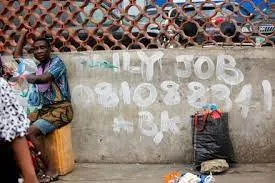The One Decade Theory: How To Undo Africa’s Ticking Time Bomb
BOYE OSHINAGA

Picture all young people as passengers on a train headed to Year 2050. To avoid an accident, that train must safely transfer most of them into another train called “The Workforce”. Failure in this operation could lead to some disaster of unclear proportions. On that trip, throw in the curveball of a few new technological upheavals causing the destination to change every now and then. Do they make it?
I think this is the most under-addresed issue of my lifetime. Donors such as USAID, Mastercard Foundation, World Bank and African Development Bank have spent an estimated $10 billion over the last 10 years to solve youth unemployment in what has amounted to slapping on a band-aid on a deep wound.
Most programs looking to create future jobs in agriculture, healthcare, technology and services have promised to turn unskilled unemployable young people, usually university graduates, into skilled paid workers or entreprenuers in 6 months to 2 years — something they ultimately fail to do, with only a few exceptions.
Despite all our efforts as a continent combined with the support of the West, unemployment is exactly what it has been, in fact slightly worse, compared with 10 years ago. For many governments, donor and private organizations, it has been big ambitions, miniscule results. What if we are thinking about this all wrong? What if there actually is a way to guarantee future employability?
To get there, we need to reconstruct our perspectives of the requirements and timelines of employability. No, it doesn’t take 6 months or 2 years. It takes 10 years. And starts with children aged 10, just around the time they graduate from primary school. The next $10bn thrown at this problem should go into building systems that do two things in quick succession:
Build skills for Thinking & Engagement
Build skills for Economic Specialization
Each step should generally take 5 years. While this may not apply broadly across all sets of skills (for example it takes doctors about 10 years to specialize), it is a very useful framework to solve this problem. Plus you know what they say about planting trees — best time was a decade ago, the next best time is now.
Before we delve into what these steps entail, it is important to note that you can only build these two layers on a solid foundation of literacy.
Build Foundational Literacy (aka Primary Schools)
The foundation of employability is literacy. This layer, more than any other, needs to be primarily the focus of any African government. There’s lot of help further down but no one can help you like you can help yourself at this stage. This is where we know to what extent education is a human right in a country. Cracks here can translate to an unstoppable snowball.
In Nigeria, every child born has a 92.6%* chance of being irreversibly lost to unemployment and its attendant effects in 10 years. The government should be racing to deliver measurable numeracy, reading and writing literacy outcomes for all primary school-age children. Out of the box thinking is required here, because the buy-chairs, buy-textbooks and hire-a-bunch-of-teachers approach is not sufficient. It would not be an exaggeration of this point if all the apparatus and resources of the Ministry of Education were dedicated to this alone. But even pragmatically, upwards of 70% of their budget should go here. And the only report card we should see is: “X million children at age 10 have sufficiently demonstrated literacy”.
Build skills for Thinking & Engagement (aka Secondary Schools)
In my proposed Decade’s theory, roughly half the decade should focus on helping literate children expanding their abilities to think critically, communicate clearly, collaborate easily and solve problems creatively whether within their personal lives or their communities. These are aptly called 21st century skills and they are needed more than ever in the Age of Intelligence. It’s not a fancy thing to say that in an AI-driven world, merely recanting of facts and storing knowledge (which most school leaving exams test on) is not as useful. What we must do is move upstream the Bloom’s Taxonomy to applying, evaluating and creating.
Life skills such as entrepreneurship, financial or digital literacy, are valuable at this stage and help to broaden the subjects that the skills of thinking and engagement can be applied to. However, it is not the best use of this time to go deep into any one subject or to treat too many subjects at once. The most important thing to do for young people here is build synaptic pathways for problem solving and learning how to learn about whatever subject matter they come across. Deeply addressing vocational skills at this stage is preposterous. It belongs to the next 5 years.
This is a stage that government can decentralise comfortably, working with private institutions, NGOs, donors, missionaries and so on, but evaluating and supporting outcomes from behind.
Build skills for Economic Specialisation (Tertiary Schools)
“Universities are designed in their own image. They reward a certain type of intelligence, and a certain type of talent, which happens to be academic.”
Sir Ken Robinson
We have set up tertiary schools, including polytechnics in Nigeria, to create mini-professors. This is despite the fact that academic jobs are a minuscule fraction of the economy. The purpose of post-secondary education is not degrees or certificates, but economic specialisation.
The outcome of this stage should get significantly input from employers in the private and public sectors and generally reflect the economy, established and emerging. If the economy does not have space for 100,000 zoologist, we should not be training 100,000 Zoology students in universities everywhere. Such misallocation represents gross negligence and clear embrace of waste.
Also universities can be safely privatised with government’s role focused on subsidising promising future workers with loans and grants to pursue skills that produce incomes in 5 years.
Conclusion
In conclusion, I am hoping this theory helps you reframe employability, identifies government’s role in solving this problem and can begin the conversation of allocating donor funding for a timeline that is midterm by any standards. We have two decades and half before it’s 2050 but the dawn of the Nigerian and African restive youth population is upon us.
If work is started now, we increase by a significant margin, the chances that most of the occupants of the Youth train get transferred to the Workforce train . But if you still expect the fashionable 6 months youth training programs or quick-start entrepreneurship programs to save us, let’s talk again in 10 years.
NOTE: *Statistic combines rate of out of school children (26%) with rate of learning poverty (90%).










